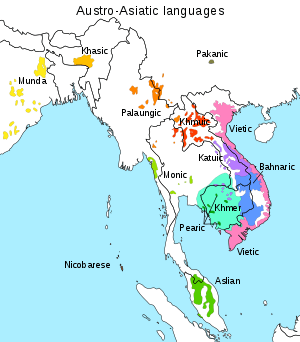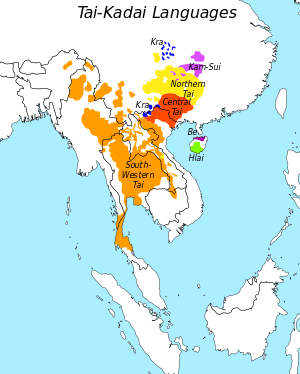Austric languages
The Austric languages are a proposed language family that includes the Austronesian languages spoken in Taiwan, Maritime Southeast Asia, the Pacific Islands, and Madagascar, as well as the Austroasiatic languages spoken in Mainland Southeast Asia and South Asia. A genetic relationship between these language families is seen as plausible by some scholars, but remains unproven.[1][2]
| Austric | |
|---|---|
| (proposed) | |
| Geographic distribution | Southeast Asia, Pacific Islands, South Asia, East Asia, Madagascar |
| Linguistic classification | Proposed language family |
| Subdivisions |
|
| Glottolog | None |
Additionally, the Kra–Dai languages and Hmong–Mien languages are included by some linguists, and even Japanese was speculated to be Austric in an early version of the hypothesis.[3]
History
The Austric macrofamily was first proposed by the German missionary Wilhelm Schmidt in 1906. He showed phonological, morphological, and lexical evidence to support the existence of an Austric phylum consisting of Austroasiatic and Austronesian.[4][lower-alpha 1] Schmidt's proposal had a mixed reception among scholars of Southeast Asian languages, and received only little scholarly attention in the following decades.[5]
Research interest into Austric resurged in the late 20th century,[6] culminating in a series of articles by La Vaughn H. Hayes who presented a corpus of Proto-Austric vocabulary together with a reconstruction of Proto-Austric phonology,[7] and by Lawrence Reid, focussing on morphological evidence.[8]
Evidence
Reid list the following pairs as "probable" cognates between Proto-Austroasiatic and Proto-Austronesian.[9]
| Gloss | ashes | dog | snake | belly | eye | father | mother | rotten | buy |
|---|---|---|---|---|---|---|---|---|---|
| Proto-Austroasiatic | *qabuh | *cu(q) | *[su](l̩)aR | *ta?al/*ti?al | *mə(n)ta(q) | *(qa)ma(ma) | *(na)na | *ɣok | *pə[l̩]i |
| Proto-Austronesian | *qabu | *asu | *SulaR | *tiaN | *maCa | *t-ama | *t-ina | *ma-buRuk | *beli |
Among the morphological evidence, he compares reconstructed affixes such as:[10]
- *pa- 'causative' (Proto-Austroasiatic, Proto-Austronesian)
- *<um> 'agentive' (Proto-Austroasiatic, Proto-Austronesian)
- *<in> 'instrumental' (Proto-Austroasiatic), 'nominalizer' (Proto-Austronesian).
Extended proposals
The first extension to Austric was first proposed Wilhelm Schmidt himself, who speculated about including Japanese within Austric, mainly because of assumed similarities between Japanese and the Austronesian languages.[11] While the proposal about a link between Austronesian and Japanese still enjoys some following as a separate hypothesis, the inclusion of Japanese was not adopted by later proponents of Austric.
In 1942, Paul K. Benedict provisionally accepted the Austric hypothesis and extended it to include the Kra–Dai (Thai–Kadai) languages as an immediate sister branch to Austronesian, and further speculated on the possibility to include the Hmong–Mien (Miao–Yao) languages as well.[12] However, he later abandoned the Austric proposal in favor of an extended version of the Austro-Tai hypothesis.[13]
Sergei Starostin adopted Benedict's extended 1942 version of Austric (i.e. including Kra–Dai and Hmong–Mien) within the framework of his larger Dené–Daic proposal, with Austric as a coordinate branch to Dené–Caucasian, as shown in the tree below.[14]
| Dene‑Daic |
| ||||||||||||||||||||||||||||||
Reception
In the second half of the last century, Paul K. Benedict raised a vocal critique of the Austric proposal, eventually calling it an 'extinct' proto-language.[15][13]
Hayes' lexical comparisons, which were presented as supporting evidence for Austric between 1992 and 2001, were criticized for the greater part as methodologically unsound by several reviewers.[16][17] Robert Blust, a leading scholar in the field of Austronesian comparative linguistics, pointed out "the radical disjunction of morphological and lexical evidence" which characterizes the Austric proposal; while he accepts the morphological correspondences between Austronesian and Austroasiatic as possible evidence for a remote genetic relationship, he considers the lexical evidence unconvincing.[18]
A 2015 analysis using the Automated Similarity Judgment Program (ASJP) did not support the Austric hypothesis. In this analysis, the supposed "core" components of Austric were assigned to two separate, unrelated clades: Austro-Tai and Austroasiatic-Japonic.[19] Note however that ASJP is not widely accepted among historical linguists as an adequate method to establish or evaluate relationships between language families.[20]
Distributions
 Distribution of Austroasiatic languages
Distribution of Austroasiatic languages.png) Distribution of Austronesian languages
Distribution of Austronesian languages Distribution of Kra–Dai languages
Distribution of Kra–Dai languages Distribution of Hmong–Mien languages
Distribution of Hmong–Mien languages
See also
Notes
- The terms "Austroasiatic" and "Austronesian" were in fact both coined by Schmidt. The previous common designations "Mon-Khmer" and "Malayo-Polynesian" are still in use, but each with a scope that is more limited than "Austroasiatic" and "Austronesian".
References
- Reid (2009).
- Blust (2013), pp. 696–703.
- van Driem (2001), p. 298.
- Schmidt (1906).
- Blust (2013), p. 697.
- Shorto (1976), Diffloth (1990), Diffloth (1994).
- Hayes (1992), Hayes (1997), Hayes (1999), Hayes (2000), Hayes (2001).
- Reid (1994), Reid (1999), Reid (2005).
- Reid (2005), p. 150–151.
- Reid (2005), p. 146.
- Schmidt (1930).
- Benedict (1942).
- Benedict (1991).
- Cited in van Driem (2005), p. 309
- Benedict (1976).
- Reid (2005), p. 134.
- Blust (2013), pp. 700–703.
- Blust (2013), pp. 703.
- Jäger (2015), p. 12754.
- Cf. comments by Adelaar, Blust and Campbell in Holman (2011).
Works cited
- Benedict, Paul K. (1942). "Thai, Kadai, and Indonesian: A New Alignment in Southeastern Asia". American Anthropologist. 4 (44): 576–601. doi:10.1525/aa.1942.44.4.02a00040.CS1 maint: ref=harv (link)
- ——— (1976). "Austro-Thai and Austroasiatic". In Jenner, Philip N.; Thompson, Laurence C.; Starosta, Stanley (eds.). Austroasiatic Studies, Part I. Oceanic Linguistics Special Publications. Honolulu: University of Hawai‘i Press. pp. 1–36. JSTOR 20019153.CS1 maint: ref=harv (link)
- ——— (1991). "Austric: An 'Extinct' Proto-language". In Davidson, Jeremy H. C. S. (ed.). Austroasiatic Languages: Essays in Honour of H. L. Shorto. London: School of Oriental and African Studies. pp. 7–11.CS1 maint: ref=harv (link)
- Blust, Robert (2013). The Austronesian Languages (revised ed.). Australian National University. hdl:1885/10191. ISBN 978-1-922185-07-5.CS1 maint: ref=harv (link)
- Diffloth, Gerard (1990). "What Happened to Austric?" (PDF). Mon–Khmer Studies. 16–17: 1–9.CS1 maint: ref=harv (link)
- ——— (1994). "The lexical evidence for Austric so far". Oceanic Linguistics. 33 (2): 309–321. doi:10.2307/3623131. JSTOR 3623131.CS1 maint: ref=harv (link)
- van Driem, George (2001). Languages of the Himalayas. Vol. 1. Leiden: BRILL. ISBN 9004120629.CS1 maint: ref=harv (link)
- ——— (2005). "Sino-Austronesian vs. Sino-Caucasian, Sino-Bodic vs. Sino-Tibetan, and Tibeto-Burman as default theory" (PDF). In Yadava, Yogendra P. (ed.). Contemporary Issues in Nepalese Linguistics. Linguistic Society of Nepal. pp. 285–338. ISBN 978-99946-57-69-8.CS1 maint: ref=harv (link)
- Hayes, La Vaughn H. (1992). "On the Track of Austric, Part I: Introduction" (PDF). Mon–Khmer Studies. 21: 143–77.CS1 maint: ref=harv (link)
- ——— (1997). "On the Track of Austric, Part II: Consonant Mutation in Early Austroasiatic" (PDF). Mon–Khmer Studies. 27: 13–41.CS1 maint: ref=harv (link)
- ——— (1999). "On the Track of Austric, Part III: Basic Vocabulary Correspondence" (PDF). Mon–Khmer Studies. 29: 1–34.CS1 maint: ref=harv (link)
- ——— (2000). "The Austric Denti-alveolar Sibilants". Mother Tongue. 5: 1–12.CS1 maint: ref=harv (link)
- ——— (2001). "On the Origin of Affricates in Austric". Mother Tongue. 6: 95–117.CS1 maint: ref=harv (link)
- Holman, Eric W. (2011). "Automated Dating of the World's Language Families Based on Lexical Similarity" (PDF). Current Anthropology. 52 (6): 841–875. doi:10.1086/662127. hdl:2066/94255.CS1 maint: ref=harv (link)
- Jäger, Gerhard (2015). "Support for linguistic macrofamilies from weighted sequence alignment". PNAS. 112 (41): 12752–12757. Bibcode:2015PNAS..11212752J. doi:10.1073/pnas.1500331112. PMC 4611657. PMID 26403857.CS1 maint: ref=harv (link)
- Reid, Lawrence A. (1994). "Morphological evidence for Austric" (PDF). Oceanic Linguistics. 33 (2): 323–344. doi:10.2307/3623132. hdl:10125/32987. JSTOR 3623132.CS1 maint: ref=harv (link)
- ——— (1999). "New linguistic evidence for the Austric hypothesis". In Zeitoun, Elizabeth; Li, Paul Jen-kuei (eds.). Selected Papers from the Eighth International Conference on Austronesian Linguistics. Taipei: Academia Sinica. pp. 5–30.CS1 maint: ref=harv (link)
- ——— (2005). "The current status of Austric: A review and evaluation of the lexical and morphosyntactic evidence". In Sagart, Laurent; Blench, Roger; Sanchez-Mazas, Alicia (eds.). The peopling of East Asia: putting together archaeology, linguistics and genetics. London: Routledge Curzon. hdl:10125/33009.CS1 maint: ref=harv (link)
- ——— (2009). "Austric Hypothesis". In Brown, Keith; Ogilvie, Sarah (eds.). Concise Encyclopaedia of Languages of the World. Oxford: Elsevier. pp. 92–94.CS1 maint: ref=harv (link)
- Schmidt, Wilhelm (1906). "Die Mon–Khmer-Völker, ein Bindeglied zwischen Völkern Zentralasiens und Austronesiens ('[The Mon–Khmer Peoples, a Link between the Peoples of Central Asia and Austronesia')". Archiv für Anthropologie. 5: 59–109.CS1 maint: ref=harv (link)
- ——— (1930). "Die Beziehungen der austrischen Sprachen zum Japanischen ('The connections of the Austric languages to Japanese')". Wiener Beitrag zur Kulturgeschichte und Linguistik. 1: 239–51.CS1 maint: ref=harv (link).
- Shorto, H. L. (1976). "In Defense of Austric". Computational Analyses of Asian and African Languages. 6: 95–104.CS1 maint: ref=harv (link)
- Solnit, David B. (1992). "Japanese/Austro-Tai By Paul K. Benedict (review)". Language. 68 (1): 188–196. doi:10.1353/lan.1992.0061. ISSN 1535-0665.CS1 maint: ref=harv (link)
Further reading
- Blazhek, Vaclav. 2000. Comments on Hayes "The Austric Denti-alveolar Sibilants". Mother Tongue V:15-17.
- Blust, Robert. 1996. Beyond the Austronesian homeland: The Austric hypothesis and its implications for archaeology. In: Prehistoric Settlement of the Pacific, ed. by Ward H.Goodenough, ISBN 978-0-87169-865-0 DIANE Publishing Co, Collingdale PA, 1996, pp. 117–137. (Transactions of the American Philosophical Society 86.5. (Philadelphia: American Philosophical Society).
- Blust, Robert. 2000. Comments on Hayes, "The Austric Denti-alveolar Sibilants". Mother Tongue V:19-21.
- Fleming, Hal. 2000. LaVaughn Hayes and Robert Blust Discuss Austric. Mother Tongue V:29-32.
- Hayes, La Vaughn H. 2000. Response to Blazhek's Comments. Mother Tongue V:33-4.
- Hayes, La Vaughn H. 2000. Response to Blust's Comments. Mother Tongue V:35-7.
- Hayes, La Vaughn H. 2000. Response to Fleming's Comments. Mother Tongue V:39-40.
- Hayes, La Vaughn H. 2001. Response to Sidwell. Mother Tongue VI:123-7.
- Larish, Michael D. 2006. Possible Proto-Asian Archaic Residue and the Statigraphy of Diffusional Cumulation in Austro-Asian Languages. Paper presented at the Tenth International Conference on Austronesian Linguistics, 17–20 January 2006, Puerto Princesa City, Palawan, Philippines.
- Reid, Lawrence A. 1996. The current state of linguistic research on the relatedness of the language families of East and Southeast Asia. In: Ian C. Glover and Peter Bellwood, editorial co-ordinators, Indo-Pacific Prehistory: The Chiang Mai Papers, Volume 2, pp . 87-91. Bulletin of the Indo-Pacific Prehistory Association 15. Canberra: Australian National University.
- Sidwell, Paul. 2001. Comments on La Vaughn H. Hayes' "On the Origin of Affricates in Austric". Mother Tongue VI:119-121.
- Van Driem, George. 2000. Four Austric Theories. Mother Tongue V:23-27.
External links
- Phonologies of selected Austronesian and Austroasiatic languages
- Glossary of purported lexical links among Austronesian and Austroasiatic languages
- Papers on the Austric hypothesis
- Word lists
- Austronesian Basic Vocabulary Database: Austronesian, Tai–Kadai, Hmong–Mien, Austro-Asiatic word lists
- Comparative Tai–Kadai and Hmong–Mien Swadesh vocabulary lists (from Wiktionary's Swadesh-list appendix)